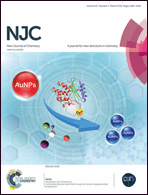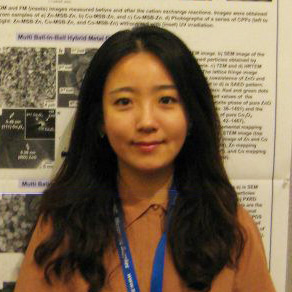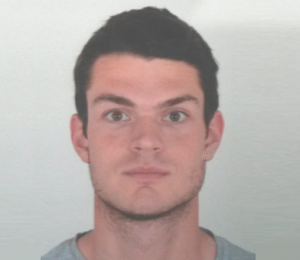From October – December 2015, our most downloaded NJC articles were:
Sangmyung Lee, Kuewhan Jang, Chanho Park, Juneseok You, Taegyu Kim, Chulhwan Im, Junoh Kang, Haneul Shin, Chang-Hwan Choi, Jinsung Park and Sungsoo Na
New J. Chem., 2015, 39, 8028-8034
DOI: 10.1039/C5NJ00668F, Paper
Christoph Janiak and Jana K. Vieth
New J. Chem., 2010,34, 2366-2388
DOI: 10.1039/C0NJ00275E, Perspective
Felix Jeremias, Dominik Fröhlich, Christoph Janiak and Stefan K. Henninger
New J. Chem., 2014, 38, 1846-1852
DOI: 10.1039/C3NJ01556D, Focus
Jianhua Shen, Yihua Zhu, Xiaoling Yang, Jie Zong, Jianmei Zhang and Chunzhong Li
New J. Chem., 2012, 36, 97-101
DOI: 10.1039/C1NJ20658C, Paper
Naoki Toshima and Tetsu Yonezawa
New J. Chem., 1998, 22, 1179-1201
DOI: 10.1039/A805753B, Paper
Sadia Khalid, Ejaz Ahmed, M. Azad Malik, David J. Lewis, Shahzad Abu Bakar, Yaqoob Khan and Paul O’Brien
New J. Chem., 2015, 39, 1013-1021
DOI: 10.1039/C4NJ01461H, Paper
Huihui Lin, Chuanxi Wang, Jiapeng Wu, Zhenzhu Xu, Yijun Huang and Chi Zhang
New J. Chem., 2015, 39, 8492-8497
DOI: 10.1039/C5NJ01698C, Paper
Xiangcheng Sun, Pavle V. Radovanovic and Bo Cui
New J. Chem., 2015, 39, 38-63
DOI: 10.1039/C4NJ01390E, Perspective
Monika Bilska-Markowska, Magdalena Rapp, Tomasz Siodła, Andrzej Katrusiak, Marcin Hoffmann and Henryk Koroniak
New J. Chem., 2014, 38, 3819-3830
DOI: 10.1039/C4NJ00317A, Paper
Jiangsheng Yu, Baofeng Zhao, Xuemei Nie, Baojin Zhou, Yang Li, Jiefeng Hai, Enwei Zhu, Linyi Bian, Hongbin Wu and Weihua Tang
New J. Chem., 2015, 39, 2248-2255
DOI: 10.1039/C4NJ02192D, Paper
Didier Astruc
New J. Chem., 2005, 29, 42-56
DOI: 10.1039/B412198H, Perspective
Zheng Ma, Hai Ming, Hui Huang, Yang Liu and Zhenhui Kang
New J. Chem., 2012, 36, 861-864
DOI: 10.1039/C2NJ20942J, Letter
Hongyu Zhen and Kan Li
New J. Chem., 2015, 39, 9031-9031
DOI: 10.1039/C5NJ90049B, Retraction

Xu Lu, Yohei Ishida and Tetsu Yonezawa
New J. Chem., 2015, 39, 6267-6273
DOI: 10.1039/C5NJ00909J, Paper
Shenguang Ge, Feifei Lan, Feng Yu and Jinghua Yu
New J. Chem., 2015, 39, 2380-2395
DOI: 10.1039/C4NJ01783H, Perspective
Teruhisa Ohno, Koji Sarukawa and Michio Matsumura
New J. Chem., 2002, 26, 1167-1170
DOI: 10.1039/B202140D, Paper
Kangfu Zhou, Yihua Zhu, Xiaoling Yang, Xin Jiang and Chunzhong Li
New J. Chem., 2011, 35, 353-359
DOI: 10.1039/C0NJ00623H, Paper
Marta Sowinska and Zofia Urbanczyk-Lipkowska
New J. Chem., 2014, 38, 2168-2203
DOI: 10.1039/C3NJ01239E, Perspective
Naresh Balsukuri, Sudipta Das and Iti Gupta
New J. Chem., 2015, 39, 482-491
DOI: 10.1039/C4NJ01086H, Paper
Luis M. Liz-Marzán and Paul Mulvaney
New J. Chem., 1998, 22, 1285-1288
DOI: 10.1039/A801214H, Paper
Xin Liu, Yuan Xie, Haobin Zhao, Xinyi Cai, Hongbin Wu, Shi-Jian Su and Yong Cao
New J. Chem., 2015, 39, 8771-8779
DOI: 10.1039/C5NJ01893E, Paper
Sailaja S. Sunkari, Bhagwan Kharediya, Satyen Saha, Bahjat Elrez and Jean-Pascal Sutter
New J. Chem., 2014, 38, 3529-3539
DOI: 10.1039/C4NJ00374H, Paper
Ananthakumar Ramadoss, Taehyun Kim, Gui-Shik Kim and Sang Jae Kim
New J. Chem., 2014, 38, 2379-2385
DOI: 10.1039/C3NJ01558K, Paper
Magdalena B. Foreiter, H. Q. Nimal Gunaratne, Peter Nockemann, Kenneth R. Seddon, Paul J. Stevenson and David F. Wassell
New J. Chem., 2013, 37, 515-533
DOI: 10.1039/C2NJ40632B, Paper
Chenglin Yan and Federico Rosei
New J. Chem., 2014, 38, 1883-1904
DOI: 10.1039/C3NJ00888F, Perspective
Comments Off on Top 25 most accessed NJC articles from October – December 2015
 This month, Guest Editors Professors Anne Galarneau (Institut Charles Gerhardt Montpellier, France) and Irina I. Ivanova (M.V. Lomonosov Moscow State University, Russia) are pleased to present a part-themed issue in honor of Dr François Fajula entitled The Creative World of Porous Materials.
This month, Guest Editors Professors Anne Galarneau (Institut Charles Gerhardt Montpellier, France) and Irina I. Ivanova (M.V. Lomonosov Moscow State University, Russia) are pleased to present a part-themed issue in honor of Dr François Fajula entitled The Creative World of Porous Materials.





























 Professor Christina Moberg (Editorial Board Member, New Journal of Chemistry), was recently elected as the new President of the Royal Swedish Academy of Sciences.
Professor Christina Moberg (Editorial Board Member, New Journal of Chemistry), was recently elected as the new President of the Royal Swedish Academy of Sciences. Professor Moberg’s own research, at the
Professor Moberg’s own research, at the 
